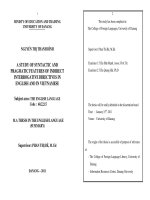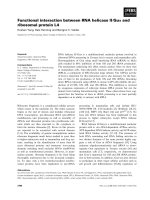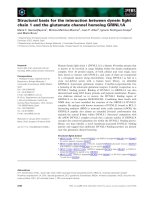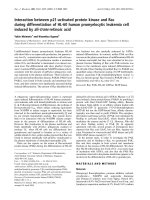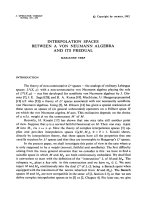Interaction between a spoolable complliant guide and coiled tubing during subsea well intervention in deep water
Bạn đang xem bản rút gọn của tài liệu. Xem và tải ngay bản đầy đủ của tài liệu tại đây (10 MB, 163 trang )
INTERACTION BETWEEN A SPOOLABLE COMPLIANT
GUIDE AND A COILED TUBING DURING SUBSEA
WELL INTERVENTION IN DEEP WATER
Simon Falser
(Dipl.-Ing.)
A THESIS SUBMITTED FOR THE DEGREE OF
MASTER OF ENGINEERING
DEPARTMENT OF CIVIL ENGINEERING
NATIONAL UNIVERSITY OF SINGAPORE
2009
ii
Acknowledgement
I am very grateful to Professor Andrew Palmer for many things, especially for his faith,
his constant guidance, encouragement and support within and beyond the frame of this
project. The words he uses to describe Bob Brown are more than applicable to himself:
“working with him gets never boring”, and I appreciate to be his student.
Many thanks to Dr. Chris Bridge; his effort and inside knowledge made such an
efficient collaboration possible. He helped me saving much time in post-processing the
numerical data by providing me his subroutines. Besides, it was pleasant to work with
him.
Thanks to Schlumberger, namely Yves Le Moign, for financing the project and myself.
Thanks also to Professor Choo Yoo Sang for bridging the fund and therefore allowing
us to work financially independent.
Thanks to the NUS Structural Lab, namely Ms. Annie Tan for her diligent help in many
ways, to Mr. Martin Loh and Mr. YK Koh for their technical assistance, and to Ms.
Norela Bte Buang for her administrative support.
Furthermore I would like to thank my friends from Innsbruck and NUS for all the
discussions and their encouragements, in particular Stefan Rainer, Barbara Rotter,
Stefano Fiori, Katherina Reich, Gerd Wieland, Tammy Chan, Cheng Ti Gan, Michael
Windeler, Eddie Hu, Kar Lu Teh, Kee Kiat Tho, Shen Wei and Jimmy Ng.
I owe a special debt of gratitude to my parents Martina and Günter, who supported and
guided me in all this years, and would like to dedicate this thesis to my treasured
grandmother Helga.
Contents
iii
Contents
Acknowledgement ........................................................................................................... ii
Contents .......................................................................................................................... iii
Summary......................................................................................................................... vi
List of tables ................................................................................................................. viii
List of figures .................................................................................................................. ix
Abbreviations ................................................................................................................ xii
Symbols .......................................................................................................................... xii
1
Introduction ......................................................................................................... 1
1.1
From the Origin into Deep Water .......................................................................... 1
1.2
Change in Technology ........................................................................................... 1
1.3
Well Intervention ................................................................................................... 4
1.4
The new Concept ................................................................................................... 6
1.5
Objectives of Study ............................................................................................... 7
1.6
Layout of Thesis .................................................................................................. 10
2
Literature Review .............................................................................................. 11
2.1
Introduction ......................................................................................................... 11
2.2
SCG System......................................................................................................... 12
2.3
CVAR Riser......................................................................................................... 15
2.4
Numerical Pipe-in-Pipe Simulation ..................................................................... 18
2.5
Pipe-in-Pipe Buckling ......................................................................................... 20
3
Subsea Intervention System.............................................................................. 23
3.1
3.1.1
3.1.2
3.1.3
SCG – Structural properties................................................................................. 24
Guide Pipe (Outer Pipe) ...................................................................................... 24
Coiled Tubing (Inner Pipe) .................................................................................. 24
Material................................................................................................................ 25
4
Physical Model Tests ......................................................................................... 26
4.1
Aim of Model Tests ............................................................................................. 26
4.2
Model Test Scaling .............................................................................................. 27
4.2.1 Scaling of Pipe in Pipe Model ............................................................................. 28
Contents
4.3
iv
Test Phases .......................................................................................................... 30
4.4
Model Setup......................................................................................................... 33
4.4.1 Strain gauge configuration .................................................................................. 35
5
Data Processing .................................................................................................. 37
5.1
Example of how to use the results ....................................................................... 40
5.2
Strain gauging ...................................................................................................... 44
5.2.1 Strain – Post Processing ...................................................................................... 47
5.2.2 Normalisation Parameters ................................................................................... 48
6
Model Test Results ............................................................................................ 49
6.1
Independent axial behaviour of Inner- and Outer Pipe ....................................... 49
6.2
Tension along Outer Pipe .................................................................................... 51
6.3
Global in-plane Bending Moment Mz ................................................................. 57
6.4
Local in-plane Bending Moment Mz,l.................................................................. 59
6.5
Global out-of-plane Bending Moment My .......................................................... 64
6.6
Local out-of-plane Bending Moment My,l ........................................................... 65
6.7
Lifting of Outer Pipe ........................................................................................... 66
6.8
Residual Bending................................................................................................. 67
7
Numerical Results .............................................................................................. 69
7.1
Axial Force .......................................................................................................... 70
7.2
Global Bending Moment Mz ............................................................................... 74
7.3
Local Bending Moment Mz,l ................................................................................ 75
8
Comparison of Test- and Numerical Results .................................................. 79
8.1
Axial Force .......................................................................................................... 80
8.2
Global Bending Moment Mz ............................................................................... 82
8.3
Local Bending Moment Mz,l ................................................................................ 83
9
Conclusion .......................................................................................................... 85
10
Limitations and Further Research................................................................... 86
References ...................................................................................................................... 88
Appendix A: Physical Model Test ReAsults ............................................................... 91
Appendix B: Physical Model Test – Comparison of different Pipe in Pipe
Diameter Ratios ............................................................................................... 104
Appendix C: Physical Model Test – Comparison of different Inclination
Angles................................................................................................................ 108
Appendix D: Numerical Model Test Results ............................................................ 113
Contents
D.1
v
ABAQUS Input File sample .............................................................................. 114
Appendix E: Numerical Model Test – Comparison of different Pipe-in-Pipe
Diameter Ratios ............................................................................................... 128
Appendix F: Comparison of Physical- and Numerical Test Results ...................... 132
Appendix G: Physical Model Test: Equipment Drawings ...................................... 146
Summary
vi
Summary
Subsea well intervention in deep water is generally being conducted from Mobile
Offshore Drilling Units, using conventional drilling risers. Schlumberger proposes the
new idea to replace the conventional riser by a Spoolable Compliant Guide (SCG)
which could be installed on a smaller vessel, which would increase flexibility and
reduce cost.
In order to compensate heave motions, the guide is intended to form an elongated Sshape by offsetting the vessel to one side. After the guide is installed, coiled tubing is
run through the riser and inserted into the well for conducting well intervention. During
operation, this inner pipe is tensioned which compresses the outer pipe due to geometric
interaction. A major concern is that this mechanical interaction could cause local failure
or reduce the design-lifetime of the guide to a significant extent.
The aim of this model test is to investigate this pipe-in-pipe interaction. The tests focus
specifically on how the interradial gap between the two pipes and the bending angle
affects the load transfer between them. In order to do so, four test phases each with
different diameter ratios have been conducted, two with a pipe-in-pipe system and two
others with a cable replacing the inner pipe. For each phase the setup is bent into
different S-shapes with inclination angles of 30°, 45° and 60° by displacing one of its
ends. The inner pipe or cable has been tensioned by steadily increasing load, while the
stress on the outer pipe has been measured by attached strain gauges. Axial force as
well as global- and local bending moment was obtained from the reading, and has
subsequently been compared with a finite element calculation.
Summary
vii
The test results show that the load transfer between the two pipes is almost independent
of the inclined angle. The local bending moment, which is the moment caused only by
the applied load, shows proportionality to interradial gap, whereas the axial force
remains almost constant for different diameter ratios. The shape of the setup does not
change with increasing load, and governs the global in-plane bending moment of the
outer pipe.
All results are given normalised in respect to the yield force/moment of the outer pipe.
It was observed that the outer pipe was in its plastic range for all twelve tests. The
maximum axial force and local bending were measured as 0.52- and 0.22 of the outer
pipe’s yield capacity respectively. The load transferred into axial force in the guide pipe
can be estimated as maximum 1.3 times the load applied. The local bending moment
can be estimated as 0.81 times the load times the radial gap normalised by the inner
diameter to the power of 0.25. The test results match the numerical results within an
acceptable order of magnitude.
viii
List of tables
Table 2-1 Buckling coefficient at helical buckling (Aasen et al., 2002) ........................ 22
Table 3-1: Guide Pipe (Outer Pipe) properties ............................................................... 24
Table 3-2: Coiled Tubing (Inner Pipe) properties .......................................................... 25
Table 3-3: Guide Pipe and Coiled Tubing Material charachteristics.............................. 25
Table 4-1: Scaling of outer pipe representing the SCG used in phase 1 and 2 ............... 29
Table 4-2: Scaling of outer pipe representing the SCG used in phase 3 and 4 ............... 29
Table 4-3: Scaling of inner pipe representing the CT used in phase 1 and 3 ................. 30
Table 4-4: specimen material .......................................................................................... 30
Table 4-5: Test Phases .................................................................................................... 31
Table 4-6: Conducted model tests with their corresponding prototype load .................. 32
Table 5-1: Test steps for each phase; coordinates refer to their definition in Figure
4.3 ...................................................................................................................... 37
Table 5-2: Prototype characteristics ............................................................................... 43
Table 6-1: graph values of Figure 6.5 ............................................................................. 53
Table 6-2: Parameters to calculate the axial force in the guide pipe .............................. 53
Table 6-3: graph values of Figure 6.6 ............................................................................. 56
Table 6-4 graph values of Figure 6.11 ............................................................................ 60
Table 6-5: graph values of Figure 6.12 ........................................................................... 61
Table 6-6: Parameters for local bending moment calculation ........................................ 62
Table 6-7: Phase 1, bending radii, residual bending radii and curvature for the
scaled model pipe ................................................................................................ 67
Table 7-1: Finite element type and number used ............................................................ 69
Table 7-2: graph values of Figure 7.4 ............................................................................. 72
Table 7-3: graph values of Figure 7.9 ............................................................................. 77
Table 8-1: graph values of Figure 8.3 ............................................................................. 81
Table 8-2: graph values of Figure 8.6 ............................................................................. 84
ix
List of figures
Figure 1.1: Illustration of different offshore structures and subsea equipment ................ 2
Figure 1.2: Different flexible riser shapes and catenary riser (upper right picture),
not to scale (API-RP-2RD) ................................................................................... 4
Figure 1.3: Schematic of simultaneous production by an FPSO (right) and drilling
or well intervention by a semisubmersible (left) (courtesy of Petro Canada)....... 6
Figure 1.4: 60° inclined system during Phase 1 test ......................................................... 9
Figure 2.1: Local moment and local effective tension for real scale pipe-in-pipe
analysis (Schlumberger, 2009) ............................................................................ 13
Figure 2.2: ITT31 FE-contact element modelling a riser-buoyancy can interaction
(Luk et al., 2009). ................................................................................................ 18
Figure 3.1: System overview of subsea well intervention due an SCG (courtesy of
Schlumberger) ..................................................................................................... 23
Figure 3.2: possible vessel positions and SCG shapes during operation (courtesy of
Schlumberger) ..................................................................................................... 24
Figure 4.1: Mechanical interaction between SCG and CT ............................................. 27
Figure 4.2: 60° inclined 25.4 mm pipe during test phase 3 and 4 .................................. 33
Figure 4.3: plan of principle model set up ...................................................................... 34
Figure 4.4: clamps to fix the SCG at its respective ends ................................................ 35
Figure 4.5: four gauge configuration .............................................................................. 36
Figure 5.1: Formed shapes for different inclination angles ............................................ 38
Figure 5.2: picture A shows the section where the pipe bends out of its constraint
axis; picture B shows the end where the pipe follows its constraint axis
before forming the S-shape ................................................................................. 39
Figure 5.3: example result sheet of physical model test in dimensional values ............. 41
Figure 5.4: typical result sheet of physical model test in normalised values.................. 42
Figure 5.5: graph-use example........................................................................................ 44
Figure 5.6: Split of real stress (b) into axial force stress (c) and pure bending (d) ........ 46
Figure 6.1: Test to show axial independence of both pipes in straight alignment .......... 49
Figure 6.2: Axial force along the straight pipe in pipe system ....................................... 50
Figure 6.3: Phase 2, Tension along the SCG for different inclination angles ................ 51
Figure 6.4: Phase 3, Tension evolution in outer pipe for different inclination angles.... 52
Figure 6.5: Phase 3, load-response for different inclination angles................................ 52
Figure 6.6: Tension evolution in outer pipe for different diameter ratios all bent 30° ... 55
Figure 6.7: Change in top tension for all bending angles with increasing interradial
gap for 7 % loading. ............................................................................................ 56
x
Figure 6.8: Phase 1, global in-plane bending moment Mz along outer pipe for
different inclination angles.................................................................................. 57
Figure 6.9: Global in-plane bending moments for 45° bend .......................................... 58
Figure 6.10: Phase 1, Local moment Mz,l along the SCG for different inclination
angles .................................................................................................................. 59
Figure 6.11: Phase 2, Increase in local moment along the SCG for different
inclination angles ................................................................................................ 60
Figure 6.12: Change in local bending moment with change in inner pipe load for
different interradial gaps as stated in mm, all bent 30° ....................................... 61
Figure 6.13: Change in local bending moment for increasing diameter ratio for all
investigated inclination angles ............................................................................ 63
Figure 6.14: Phase 3, Global out-of-plane bending moment My along the outer pipe
for different inclination angles ............................................................................ 64
Figure 6.15: Phase 3, Local out-of plane bending moment for different inclination
angles .................................................................................................................. 65
Figure 6.16: Phase 1, lifting of SCG for 29% loading .................................................... 66
Figure 7.1: Plan view of 30° bend numerical model for all phases ................................ 70
Figure 7.2: Phase 1, numerical tension along outer pipe for different inclination
angles .................................................................................................................. 71
Figure 7.3: Numerical tension along outer pipe for all phases 60° bend ........................ 71
Figure 7.4: Numerical change in top tension with increasing load and different
diameter ratios all 45° bend ............................................................................... 72
Figure 7.5: Numerical change in top tension with increasing interradial gap for all
investigated bending angles and 7 % y.c. loading of the respective outer pipe .. 73
Figure 7.6: Numerical global in-plane bending moment Mz for different diameter
ratios all 30° bend ............................................................................................... 74
Figure 7.7: Phase 1, numerical local moment MZ,l along the SCG for different
inclination angles ................................................................................................ 75
Figure 7.8: Numerical in-plane bending moment ........................................................... 76
Figure 7.9: Numerical change in numerical local bending moment with change in
inner pipe load for different interradial gaps as stated in mm, all bent 30° ........ 76
Figure 7.10: Numerical change in local bending moment with increasing interradial
gap 77
Figure 8.1: Phase 3, shape comparison between the physical and numerical model
for 45° inclination angle ...................................................................................... 79
Figure 8.2: Phase 3, comparison of global moment for 45° bend and 12% y.c.
loading ................................................................................................................. 80
Figure 8.3 Phase 3, comparison of increase in top tension with increasing load
between the physical- and numerical model for 45° bend .................................. 81
Figure 8.4: Phase 3, comparison of global in-plane moment for 45° bend .................... 82
xi
Figure 8.5: Phase 3, comparison of local in-plane bending moment for 45° bend and
12 % SMYS loading ........................................................................................... 83
Figure 8.6: Phase 3, comparison change local bending moment Mz.l with increasing
load between the physical- and numerical model for 45° bend .......................... 84
Figure G.1: Overview of items used to cuonduct the model tests ................................ 147
Figure G.2: Clamp configuration .................................................................................. 147
Figure G.3: Detail upper base ....................................................................................... 148
Figure G.4: Detail lower base ....................................................................................... 148
Figure G.5: Detail loadcell box..................................................................................... 149
Figure G.6: Detail 1/2" cover........................................................................................ 149
Figure G.7: Detail 1" cover ........................................................................................... 150
Figure G.8: detail loadchair .......................................................................................... 150
Figure G.9: Strain gauge configuration ........................................................................ 151
Figure G.10: Tensile test of OD 1/2" pipe used in Phase 1 and 2 ................................ 151
xii
Abbreviations
Ac
cross-section area
CT
Coiled Tubing
CVAR
Compliant Vertical Access Riser
FPSO
Floating Production Storage and Offloading vessel
gr
interradial gap
HCR
Highly Compliant Riser
ID
inner diameter
JIP
Joint Industrial Project
MODU
Mobile Offshore Drilling Unit
OD
outer diameter
SCG
Spoolable Compliant Guide
SCR
Steel Catenary Riser
SMYS
specific minimum yield stress
TTR
Top Tension Riser
VIV
Vortex Induced Vibration
WT
wall thickness
y.c.
yield capacity
Symbols
cTT
factor for top tension
cTT
factor for top tension
E
Young’s modulus
Fyield
yield force
Myield
yield moment
S
section modulus
Y
yield stress
α
inclination angle
ε
strain
σ
stres
Chapter 1: Introduction
1
Introduction
1.1
From the Origin into Deep Water
1
The modern oil and gas industry was initiated in the early 1859 with the first recorded
oil findings through drilling in Titusville, Pennsylvania, USA. The potential for huge
profits, drove many people quickly into the oil and gas business. The industry grew fast
and a powerful energy industry was established. Large and easily accessible reservoirs
were found, and the global oil reserves were theoretically secure for many decades.
However, new findings together with constantly changing regulations and much
political gambling dominated the global petroleum market ever since (Yergin, 1990),
and the oil price quickly established itself to an important index of the world economy’s
wellbeing.
Over many decades, the steadily increasing demand of petroleum was met by increasing
production from onshore and shallow water reservoirs, and as a result the oil price had
no technical reason to rise. As most of the easily accessible resources started to decline,
however, oil became more expensive, since oil companies were forced to produce from
reservoirs in deeper water, which required new and costlier technology.
1.2
Change in Technology
Fixed platforms on jackets or compliant towers were soon replaced by floating
structures as more than 600 m water depth were reached. Floating production rigs such
as Semisubmersibles, Tension Leg Platforms (TLP’s), Spars and Floating Production
Storage and Offloading vessels (FPSO’s) as illustrated in Figure 1.1 are expensive,
since they have to be designed to withstand harsh offshore environment for their entire
Chapter 1: Introduction
2
design lifetime, some such as Spars and TLP’s without being brought back to shore. At
the same time though, their payload capacity had to be maximise for drilling or
production. More about offshore structures can be found in Chakrabarti (2005).
Jacket
Jackup
TLP
Semisubmersible
FPSO
Manifold
Wellheads
Figure 1.1: Illustration of different offshore structures and subsea equipment
The number of production hubs per oilfield was kept at its minimum, which, depending
on the form and dimensions of the reservoir, makes the platform to a central hub for
several square kilometres above the produced field.
Oil and gas reach the seabed through drilled wells into the reservoir. A subsea (wet) tree
on top of the wellhead connects each well to a manifold, which in simple terms gathers
the product from a few wells, and pumps it through production risers to the floating
platform (Figure 1.1). There are several types of risers, and their principal distinction is
between drilling- and production riser on fixed- or floating structures.
Chapter 1: Introduction
3
Drilling riser are purely vertical and have the purpose to guide the drilling string and to
keep the drilling mud and cuttings in a closed system. They have to be installed from a
specially equipped drilling rig, by joining several pipes together and connecting it to the
preinstalled wellhead.
Production risers on the other hand can be designed in different ways, each with a
different method to compensate heave motions. Depending on the water depth, the
maximum heave amplitude, the production rate and therefore the riser’s diameter, as
well as the type of floater they are connected to are influential for the choice and design
of production risers: A Top Tension Riser (TTR) works similar to the drilling riser,
which is vertically connected to the wellhead with a heave compensator on deck. Steel
Catenary Riser (SCR) form a catenary shape between a horizontal tangent on the seabed
and a vertical at its connection on deck, whereby heave motion is compensated by a
controlled cyclic lifting of the riser in its touch-down-zone on the seabed (Bai, 2001).
An alternative method is the Compliant Vertical Access Riser (CVAR), where the steel
riser takes up a buoyancy supported, stretched S-shape which itself compensates heave
motion. Flexible risers and umbilicals are also being used in various shapes such as
lazy- or steep wave and lazy- or steep S, depending on their method of buoyant support
as shown in Figure 1.2. Lazy S risers generally differ from the lazy wave risers as their
buoyancy support is moored to the seabed.
Chapter 1: Introduction
4
Figure 1.2: Different flexible riser shapes and catenary riser (upper right picture), not to
scale (API-RP-2RD)
As one might expect, riser design for floating structures is much more challenging than
for fixed platforms. The riser is free hanging or partially supported by buoyancy over
the whole water column, and is exposed to much larger hydrodynamic forces compared
to a riser attached to a jacked leg in shallow water.
1.3
Well Intervention
Production wells need maintenance, since either sand flows into the well or oil residuals
are getting stuck on its wall. Both have to be removed in order to guarantee flow
assurance and not to jeopardise the production rate, which is the core piece of any
petroleum production. Enhanced recovery is another aspect in which well intervention
is necessary. Thereby coiled tubing is run into the well and the reservoir rock’s
Chapter 1: Introduction
5
permeability is increased either locally due to chemicals (acidizing), or due high
pressure with which the rock is being fractured (fracturing). For heavy oil recovery,
however, the oil’s high viscosity has to be decreased by either heating due to steam
flooding or local combustion, before a conventional production is possible. Further
information about enhanced- or tertiary recovery can be found in Archer and Wall
(1986).
Most well interventions require a separate connection between the well and the vessel
from where the intervention is being conducted, except for TTR and CVAR riser, where
the intervention can be conducted through the installed production riser, but the first is
not applicable for deep water and the latter is not much used either. Therefore for well
intervention, the same riser as for drilling is generally being used, where an equipped
Mobile Offshore Drilling Unit (MODU) has to be installed above the well as illustrated
in Figure 1.3. The vessel’s heave motions are thereby compensated by a telescopic riser
section at its connection to the vessel. Figure 1.3 also shows a flexible lazy-S
production riser connected to a FPSO.
With the oil price at record heights in recent years, several oilfields became suddenly
economical to explore and eventually to be produced from. That boom toward
exploration caused a sudden shortage in drilling rigs, and fabrication yards worked on
their limits to coup with the demand. Since most new fields were either in deep water or
arctic environment, drilling rigs had to be designed more robust which obviously
increased cost. A combination of the shortage and the newly build high end drilling rigs
or drillships pushed their leasing rates up to several hundred thousand US-dollar per
day, and made well intervention unnecessarily expensive.
Chapter 1: Introduction
6
Export Tanker
FPSO
Flexible lazy-S
production riser
DrillingSemisubmersible
Mooring lines
Drilling riser
Wellheads
Figure 1.3: Schematic of simultaneous production by an FPSO (left) and drilling or well
intervention by a semisubmersible (MODU) (right) (courtesy of Petro Canada)
1.4
The new Concept
Schlumberger sees a potential to make well intervention cheaper and more flexible, as
they are developing a new device which does not require a drilling vessel.
The new idea is a Spoolable Compliant Guide (SCG), which is a small diameter steel
riser reeled onto a wheel and installed on a small conventional vessel. On site, the guide
gets unreeled and connected to the wellhead. Similar to the CVAR, the riser will form
an elongated S-shape to compensate heave motion, as can be seen in Figure 3.1. After
installation coiled tubing is run into the guide ready to operate the intervention package
pre-located on top of the wellhead. A Coiled Tubing (CT) is also a small diameter steel
pipe reeled onto a wheel, and is used in many different kinds of downhole-operations
throughout the oil and gas industry. After the well intervention is carried out, the CT
Chapter 1: Introduction
7
and subsequently the SCG are being recovered by reeling up, and the vessel can sail on.
Another advantage compared to the conventional workover system is that the dynamic
seal, which seals the coiled tubing inside the riser, is located subsea in the upper
intervention package, and not on vessel deck as it is in conventional systems, which is
possibly beneficial for design and safety.
The idea is promising. There are some uncertainties and questions, none of them
critical, as is common for innovative designs. One potential problem area is wear
between the two pipes, in terms of durability of the residual bent guide and of load
transfer between the inner and the outer pipe during operation. Since the guide is
inclined, the friction forces are higher than in conventional vertical drilling risers, and
therefore the wear of the guide has to be quantified. A conservative value of the contact
force between the two pipes is used for conducting wear tests on the prototype’s
material, which consequently allows an estimation of the SCG’s durability. A lubricant
could be used to reduce friction and minimise wear on the inner wall of the guide. The
residual bend is not expected to have much influence on the guide’s shape, and since the
inner pipe is lowered after the guide is installed, residual bending does not affect the
pipe-in-pipe interaction and has therefore only to be checked to make sure that lowcycle fatigue will not occur.
1.5
Objectives of Study
This study intends to reduce uncertainties of load transfer during operation. For
different well interventions it is necessary to run the coiled tubing deep into the well to
the reservoir, whereas its dead load combined with the weight of the intervention
package tensions the inner pipe significantly. This load is partially transferred to the
Chapter 1: Introduction
8
guide pipe at the inclined section, shown in Figure 4.1 and is termed geometric
interaction.
Previous numerical calculations indicated large response forces in the guide pipe, to an
extent that local buckling due to large local moments became a concern. When the
interaction simulation was repeated numerically, it was found that local buckling might
not occur, but the load transfer due to geometric pipe in pipe interaction and friction is
nevertheless highly complex, and hence a physical model test is needed to benchmark
these results.
This research focuses in particular to which extent the pulling force compresses the
outer pipe, and how it affects the outer pipe’s global and local bending moment. The
effect of the interradial gap gr on the load transfer will also be investigated. Furthermore
it will be examined how the response changes with varying inclination angle of the pipe
configuration.
The aim is to elaborate some equations to estimate the axial force and moment in the
guide for the corresponding load applied onto the inner pipe. Figure 1.4 gives an
overview of the test setup.
Chapter 1: Introduction
Figure 1.4: 60° inclined system during Phase 1 test
9
Chapter 1: Introduction
1.6
10
Layout of Thesis
Chapter 1, Introduction, leads the reader to the topic. It intends to explain why well
intervention is necessary and how it could become cheaper with the new
system Schlumberger proposes.
Chapter 2, Literature review, aims to give some background information to the
addressed problem of geometric pipe-in-pipe interaction
Chapter 3, Subsea Intervention System, gives a brief overview of the state of the art
design of the Spoolable Compliant Guide including its technical
specifications.
Chapter 4, Physical Model Test, describes the model scaling, the model setup as well as
the different tests conducted. It intends to visualise and explain the reason
for the setup and test focus to the reader.
Chapter 5, Data Processing, describes how the gained data has been processed in order
to achieve in plane reaction forces. An example aims to show how the
normalised graphs can be used to obtain real scale responses.
Chapter 6, Model Test Results, provides and explains the most significant results
obtained from the model test. This might be the core chapter of this thesis,
which contains all research findings of the conducted study.
Chapter 7, Numerical Test Results, as in chapter 6, it provides and explains the most
significant results from the numerical calculation. In addition it intends to
support the findings from the physical model test.
Chapter 8, Comparison of Test- and Numerical Results, shows and explains similarities
and differences of the measured and calculated results.
Chapter 9, Conclusion, summarises the research finding and concludes their effect.
Chapter 10, Limitations and Future Research, highlights the limitations of the
conducted tests and gives an outlook to possible future research.
Chapter 2: Literature Review
2
Literature Review
2.1
Introduction
11
Pipe-in-pipe systems are widely used in the offshore industry. Pipe-in-pipe interaction
during drilling has been carefully researched, since the anxiety that the drilling string
may buckle within the casing and lock up is always at present.
Another subject of much research are thermally insulated pipes: As the industry moves
towards deeper water, concerns about flow assurance increase as distances from shore
increase; Heat losses along export pipelines are therefore minimised by installing pipein-pipe flowlines with thermal insulated annulus, to prevent hydrate and wax formation
in keeping the thermal conductivity high, and at the same time to save ethanol injection.
Their interaction is clearly different from the one in the SCG, but nevertheless the
contact between the two pipes during installation has been modelled by the same Finite
Elements (FE) as were used for the SCG (Daly and Bell, 2002).
In 1998 a Joint Industrial Project (JIP) was initiated to analyse Highly Compliant Rigid
(HCR) risers in large scale model tests and to compare its results with different riser
analysis software (Grant et al., 1999). One of the key objectives of this project was to
determine whether riser buckling, as predicted by some software, really occurs. Three
different risers (CVAR, SCR, Lazy Wave SCR) were modelled in a 1:4 scale in 280 m
water depth. All risers were cyclic actuated in heave motion and stress was recorded
along its axis. Results have shown that in-plane response depends on the excitation
period, whereas out-of-plane response is at the Vortex Induced Vibration (VIV)
frequency. Grant et al. show that the tension variation is highly non-linear due
intermittent occurring VIV and riser-seabed interaction for SCR’s. Furthermore the
Chapter 2: Literature Review
12
SCR riser was observed to buckle out-of-plane, which only software with out-of-plane
degrees of freedom were able to predict. The study concludes that at present the most
severe limitations of riser analysis software are their inability to model intermittent VIV
and their low accuracy modelling of deep water clays.
However, little work has yet been done to investigate the addressed question of load
transfer due to geometric interaction in a pipe-in-pipe system.
2.2
SCG System
Schlumberger provided all state of the art specifications for the SCG design, which
were necessary to scale the model and helped to identify the key factors which had to be
investigated.
In the report “Forces Along the Spoolable Compliant Guide” (Schlumberger, 2008) the
friction force along the SCG, the build-up rate of the inclination as well as the von
Mieses stress is plotted against the vessel’s offset. It was found out that for installation
of the CT, the build up rate of the guide should be less than 5°/33m, which corresponds
to a vessel offset of 220 m. That, on the other hand, causes high stress in the upper and
lower stress joint which connect the riser, and therefore it is recommended to change the
vessel positions during the CT runs through different sections of the guide. Within 0 50 m offset the von Mises stress in the guide reaches 80% SMYS, whereas in all other
positions ± 275 m the working stress of 67% SMYS is not reached.
Simultaneously to the tests presented here, Schlumberger conducted a separate
numerical study of the real scale pipe in pipe system, which results are presented in the
report “Pipe-in-Pipe Interaction using ABAQUS” (Schlumberger, 2009). These results
match the numerical results of the here presented model well. Schlumberger’s
calculation was carried out with- and without friction between the pipes, and the results
Chapter 2: Literature Review
13
show that friction reduces the local effective compression in the S-shape significantly,
as it is illustrated in Figure 2.1. It was also found that the differential load increase into
axial force is equal to -1.0 times the load applied, which reflects the result in chapter 7
and those by Kuroiwa et al. (2002).
Figure 2.1: Local moment and local effective tension for real scale pipe-in-pipe analysis
(Schlumberger, 2009)
The local moment was determined by Schlumberger as the load applied times the
interradial gap:
𝑀𝑀𝐿𝐿0 ≈ 𝑇𝑇𝐵𝐵 𝑟𝑟
(2.1)
where
ML0
is the local moment in the guide
TB
is the load applied onto the inner pipe
r
is the interradial gap
The test results in this study, however, indicate that the differential increase in local
moment dMy,l/dT is a function of the gap normalised by the inner pipe diameter to the
